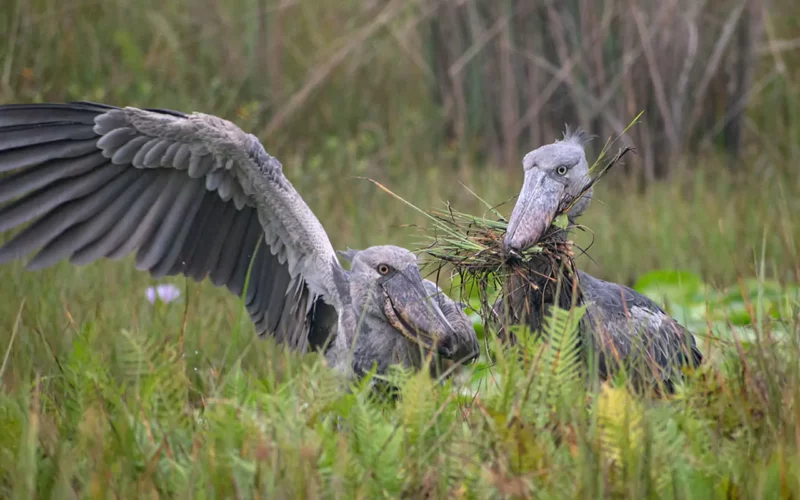The One Day Mabamba Shoebill Birding Tour explores the expansive wetlands of Mabamba for the prehistoric Shoebill and a quality list of other wetland specialists. This day-tour is ready to begin from Entebbe or Kampala and is suitable for dedicated naturalists, birders and enthusiasts.
Mabamba Wetlands is the most reliable hotspot for birders and enthusiasts seeking out the rare Shoebill and other restricted range species unique to the Lake Victoria biome, including seasonal wintering congregations. Mabamba marshes are designated as an Important Bird Area (IBA) and a Ramsar site because of the diversity it protects. Contact us to tailor this expereince just for you.
Mabamba Site Facts
- Size: 100km2
- Category: Important Bird Area and Ramsar Site
- Recorded species: 300 bird species.
Species Highlights
Shoebill, Papyrus Gonolek, Caruthers cisticola, Blue-breasted Bee-eater, Lesser Jacana, Northern Brown-throated Weaver, Long-toed Lapwing, Marsh Tchagra, Blue-headed Coucal. Other interesting resident wetland species include, Malachite and Pied Kingfisher, Lesser Swamphen, gigantic Spur-winged Goose, Yellow-billed Duck, White-faced Whistling Duck, seasonal passage migrants include Black Heron, several species of Terns and Madagascar Bee-eater. Grey and Purple Heron, African Fish Eagle and African Marsh Harrier among others.

Birding Activity
Upon arriving at the car parking at Mabamba fishing village, you will take a motorized local canoe led by a community guide to explore the wetland’s interior across and along a maze of papyrus-edged water channels. Top of our highlights will be the prehistoric Shoebill which hunts these low-oxygenated waters where its stalks mud fish, catfish and several fish species abundant here.
As we bird we will also look for papyrus specialists including; Papyrus Gonolek, Lesser Jacana, Lesser Reed Warbler, Northern Brown-throated Weaver, Black-crowned Night Heron, Straited Heron, Pygmy and Spur-winged Geese, White-faced Whistling Ducks, Black Stilt, Reed Cormorant, Purple and Grey Heron, Malachite Kingfisher, Black Crake, African Jacana, Pied Kingfisher, Caruthers’s and Winding Cisticola. The Blue-Swallow, a migrant from south equator that occurs here from May to September.
The marsh also attracts large migrant congregations of Gull billed Tern, White-winged Black Tern, Whiskered Tern, Ruff and several Sandpipers. Local waders include; Grey-headed Gulls, Little Stint, Lesser and Purple Swamphen while Yellow Wagtail, Eurasian Marsh Harrier and Osprey are seasonal migrants. African Marsh Harrier, African Fish Eagle, Palm-nut Vulture are resident raptors. The marshy edges and cultivation attract; Long-crested Eagle, Scarlet-chested and Marico Sunbirds, Western-Banded Snake Eagle, Lizard Buzzard, Red-eyed Dove, Speckled Mouse-bird, Black-headed Weaver, African Pied Wagtail, Yellow-fronted Canary, Spectacled Weaver, Hamerkop, Open- billed Stork and more.
Pick up Time
- From Entebbe: 07:00am
- From Kampala: 06:00am
One Day Birding Tour to Mabamba Includes
- Transport
- A bird guide/driver
- Drinking water
- Community entrance fees and tax
- Lunch
However, One Day Mabamba Birding Excludes
- Tips to guides
- Other drinks other than mineral water
